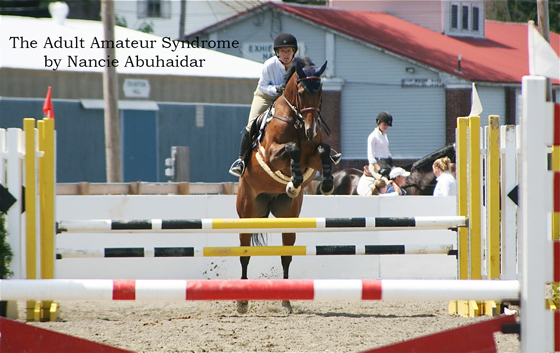The Adult Amateur Syndrome - Why Am I Now Afraid?
By Nancie Abuhaidar.

It happens to a lot of us, whether the quick result of a fall or a festering apprehension that catches us unaware—the sickening fear of what we love. It can be as mild as “I’d rather not jump that today” or an all-out “GET ME OFF THIS THING NOW!!”
I call this monster AAS (Adult Amateur Syndrome) and for a long time, I thought it was my own personal demon. I have ridden most of my life, keep my horses in my backyard, and have experienced some spectacular moments; but as I got older, had some falls and unpleasant rides, the fear started to creep in. I began making excuses: maybe I’ll just lunge, it’s too cold, it’s too hot, or I don’t want to ride alone. The list became endless. I decided to take some lessons. As soon as I joined a group, I found my own apprehensions echoed by others. So what causes AAS and what can we do to fight it?
Let’s face it. We aren’t as strong or flexible as we were when we were kids. It’s much harder to hold our position. Habits are harder to change and reaction times slow—it’s as if our bodies stop listening to what our brains want to do. We don’t bounce when we fall off. It hurts more and for longer—we simply can’t heal as fast. Sure there are 90 year-old yogis who can tie their bodies in knots, but they devote their lives to their vocation. Most of us have to work on our fitness and we don’t have the luxury of spending all day riding. We simply don’t have time.
With adulthood comes responsibility. Work, children, and home-ownership all chip away at available barn time. So here we are; at the barn after work or for a few precious weekend hours, stiff and stressed, ready to ride. And our horse suddenly has that look. The one that dares you to throw a leg over the saddle, the where-have-you-been-its-20 degrees-and-I-want-to-play look. Even if you have your horse schooled by a pro it happens. Then a little voice begins to regale you with the “what ifs.” What if I fall off? What if I break my wrist/leg/neck? What if I can’t drive? What if I miss work? It’s not a recipe for a great ride.
The bottom line is, though the reasons and situation may vary once our confidence wavers, AAS has us in its grasp. So what do we do? Short of spending time and money on sports psychology, some simple strategies and techniques can help.
Before riding, stretching helps. Anything from touching toes (or the attempt) to a sun salutation gets your muscles warmed up and ready to go. If it is possible, a few minutes of sitting on a fitness ball and rolling your hips stretches your hip flexors. Away from the barn, Pilates or yoga strengthen your core. A strong core, in turn increases your ability to balance and stabilize your body while you ride.
Once mounted, if there is something that has become challenging or starts your heart palpitating in fear, take a step back. Return to the basics. If that 2’6 vertical looks like a 4’ monster, lower the height—even to a canter pole—and build back slowly. Practice a simpler version of the task; slow it down until it feels comfortable and even boring. But don’t shy away from challenging yourself a bit once you are. The sense of accomplishing something unexpected is a huge confidence boost.
Make your time in the saddle count. What about some no stirrup work? Maybe you can’t blast around the ring posting trot multiple times, but even dropping them for short periods (a long side) improves your seat position and leg strength. Two-point or half-seat without leaning on your hands is another good mounted exercise.
Try something completely new! Pole bending improves your aids, take a lunge lesson to improve your seat, set up a simple barrel course, you can attempt a dressage test, trail ride, or start ground-driving. A change in routine recharges both you and your horse. If you ride English, try Western and vice versa. Of course, keep in mind the limitations of you and your mount—you are going for the experience, not perfection!
Set reasonable goals. With age comes wisdom…usually. We’ve made mistakes and, hopefully, learned from them. You know your limitations. That doesn’t mean skulking quietly to the back of the barn in failure, it simply means you know if you and your horse are ready to try tempi changes or nail that sliding stop. The flip-side is you realize that if you want to jump higher or roll back faster, the methodical, patient work needed to get there won’t surprise you.
Forgive yourself those bad days when nothing goes right. Chalk it up to experience. It will get better. The fear will come and go. The key thing to remember when that AAS demon comes to perch on your shoulder is why you ride. It is a joy and a passion that is worth every drop of sweat and tears.


